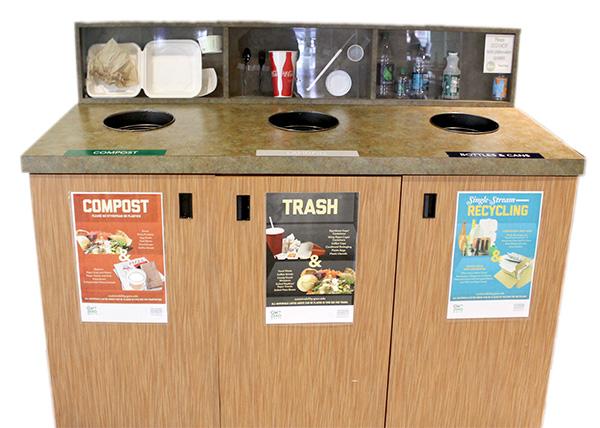Updated: Jan. 26, 2015 at 3:31 p.m.
The University has missed two deadlines for reaching goals that would make it a zero-waste college – part of its far-reaching sustainability plan to reduce its impact on the environment.
GW has not yet started to compost on a large-scale in Foggy Bottom or created a website for its furniture recycling program, a year after the target start dates for both projects passed. As schools have increasingly focused on sustainability over the last several years, experts say plans often change over time as officials prioritize projects that make the largest impact in the shortest timeframe.
Meghan Chapple, the director of GW’s sustainability office, said officials haven’t been able to launch a composting program for students on Foggy Bottom because D.C. has been “facing significant infrastructure challenges for compost collection” after one of the city’s two main compost sites closed.
The remaining compost site for the District large enough for commercial use is located in Prince George’s County, Md., and Chapple said the site “has limited capacity to accommodate the region’s needs.”
The University’s overarching ecosystem plan, created in 2012, has sections focused on eliminating food waste, cutting carbon emissions and reducing water use. On the path to producing zero waste, GW has hired two staff members focused on waste reduction and launched a single-sort recycling system so students don’t have to separate cardboard from cans. Officials have also installed water filtration systems in several buildings so they could stop buying plastic water jugs.
The University has not yet released a target date for when it will become a zero-waste school. American University, one of GW’s peers, announced in 2010 that the institution would be waste-free by 2020.
But totally eliminating waste could be a challenge for GW because projects like composting require coordination among multiple departments, said Ayrel Clark-Proffitt, the education and outreach coordinator for the University of Utah’s Sustainability Resource Center.
“The thing about university campuses is that there are generally multiple stakeholders,” Clark-Proffitt said. “Trying to meet a recycling goal brings in a lot of different parties.”
GW currently has employees compost materials at Pelham Commons on the Mount Vernon Campus and at J Street. Once D.C. expands its collection capability, GW will look at adding campus composting for students and faculty on Foggy Bottom, University spokesman Kurtis Hiatt said.
Melissa Miller, the farm manager at Common Good City Farm, said a full-blown compost program at a school the size of GW would overwhelm smaller sites, which she called “the little guys.” She said the University would have to drop off the waste – which could include wood chips, leaves or leftovers – every week at multiple small sites.
GW also planned to create a website for its “Reuse” recycling program with an online inventory by 2013. The program lets faculty and staff donate or reuse office furniture, shelving or cabinets.
Hiatt said officials have promoted the program “through other means” like emails.
“Building and maintaining a website of inventory, which changes constantly, requires significant staff member time and resources,” Hiatt said.
The University has committed to sourcing at least 20 percent of the foods it serves in its dining halls from sustainable farms by 2020, a goal it set along with Johns Hopkins University and Oberlin College, Chapple said. Among other goals in the plan, the sustainability office will also design a green chemistry lab and conduct a light pollution study.
GW has used campus construction projects to help reach its sustainability goals. Eleven buildings have received green certification from the U.S. Green Building Council since 2007. The Science and Engineering Hall, which opened this semester, has large windows and indoor greenery – two elements that Chapple said fit the “physical, mental, and social well being” components of the University’s sustainability goals.
This post was updated to reflect the following correction:
The Hatchet incorrectly attributed information about the University’s goal for food sourcing and a quote about the components of GW’s sustainability goals to University spokesman Kurtis Hiatt. Meghan Chapple, the director of the Office of Sustainability, provided the information and quote. We regret this error.







